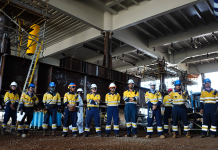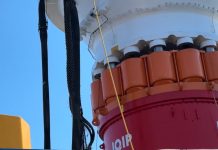Planned wind tower sites may appear firm on the surface, only to conceal a buried weak soil stratum. Depending on the depth and thickness of the weak layer, it may provide the planned tower with insufficient bearing capacity or be the cause of excessive settlement. When a weak layer is discovered prior to construction the foundation designer has several options including excavating and replacing the soil, bypassing the weak layer with a deep foundation, or improving the characteristics of the soil in situ. “Rigid inclusions” is a ground reinforcement process that transfers loads through weak stratum to firm underlying stratum, improving the weak layer’s load bearing and settlement characteristics.

Rigid inclusions consist of concrete columns installed through weak compressible strata, using upper strong strata to transfer the load to the inclusions. A closed-end pipe is advanced to a designed depth into underlying firm soils. The pipe is then filled with a concrete mix with a high internal friction. The inclusion is then constructed as the concrete fills the void created as the pipe is extracted. Construction sequence is important to avoid damaging previously constructed inclusions that are still curing.
As with the construction of any tower project, preliminary planning must include a geotechnical engineering exploration. The geotechnical report should include an evaluation of the site geological history, soil engineering properties (including density, gradation, and moisture content), and the in situ strength and compressibility characteristics of each stratum within the influence of the planned foundation. Location and information about adjacent structures and utilities should be included.
Rigid inclusions transfer the majority of the load from above the problem soil to below it. The weak stratum thereby experiences little additional load, and therefore has minimal influence on the tower’s settlement or bearing capacity. The lengths of the rigid inclusions extending into the firm soils above and below the weak stratum are designed to achieve the required load transfer. When the top of the weak stratum is at or near the foundation bearing elevation, a load transfer platform may be required. This often consists of a geogrid reinforced soil layer that acts as a mat to distribute the foundation loads to the inclusions and provide a more uniform bearing support for the foundation. At sites where fill placement is required to raise the site grade, it may be feasible to construct this relieving platform within the fill.
Although the inclusions may have the appearance of piling, there are many differences. One obvious difference is that the inclusion is not connected to the structure. The structure is directly supported by upper soils, which transfer load to the rigid inclusions. The rigid inclusions transfer the stress from the bearing soils past problem soils and into underlying firm soils. Another distinction is that the inclusions seldom require significant reinforcing steel. However, steel reinforcement is common in the upper portion of the inclusion to avoid damage due to construction of adjacent inclusions or loads from construction equipment.
The diameter and spacing of rigid inclusions varies depending on the loading, concrete strength, and subsurface conditions. Typical spacing ranges from 6-10 ft. During construction of the inclusion, the concrete is not pressurized above the fluid pressure of the concrete itself. Quality control measures include: 1) procedural inspection and documentation of the work activity; 2) testing to ensure proper mix design; 3) monitoring of concrete injection volume, and; 4) strength testing of concrete test cylinders cast during construction. Industry standards now enable owners and engineers to require computerized data acquisition systems to record construction parameters in real time. These systems will document the depth and verticality of the inclusion, the penetration time and resistance (to verify sufficient penetration into bearing stratum), and the volume of concrete. Real-time monitoring and recording of these parameters allow the operator to make necessary adjustments during construction and provide the engineer with documentation that the construction was performed properly.
When applied properly, rigid inclusions can provide the necessary ground improvement for many wind turbine sites, allowing for a shallow foundation system. In most cases, mat foundations constructed on improved soil will provide an economic advantage over deep foundation options.



























